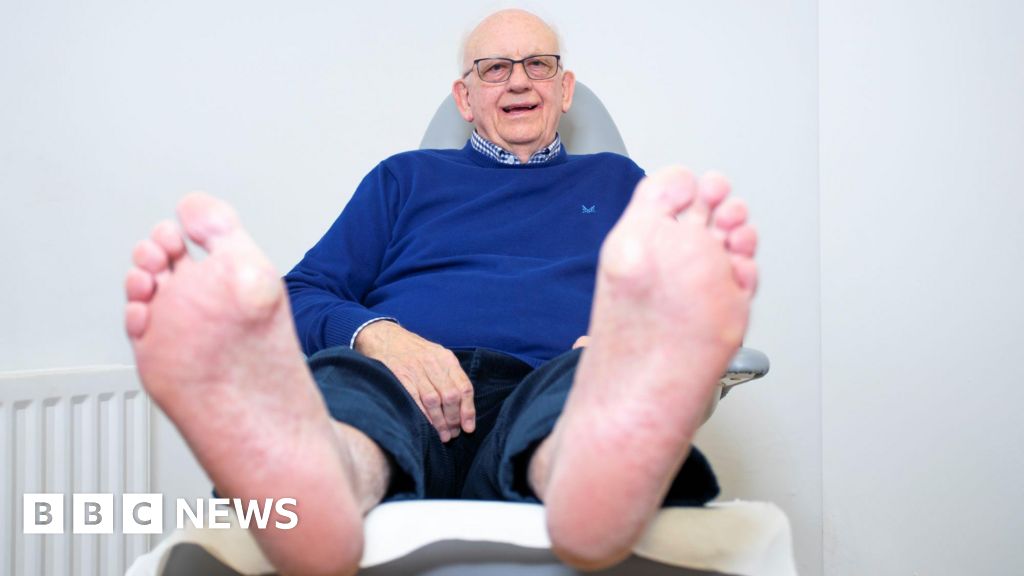A diabetes patient has saved both his legs from amputation thanks to new microwave technology.
Barry Mayled, 74, has type 2 diabetes and saw his foot ulcers get worse during the Covid pandemic, until surgeons said they had no choice but to amputate.
But Mr Mayled said a medical student who observed his treatment mentioned microwave therapy as an option and that after nine months of treatment he is now “completely cured”.
His ‘severely swollen’ feet were treated with Swift, a microwave technology developed by Stirling-based Emblation.
This uses low-energy microwaves to stimulate the immune system.
Warning: This story contains graphic images
The architect and gardener from Penarth in the Vale of Glamorgan said he wanted to continue working and have a good quality of life in retirement.
But he admitted the idea of losing his legs was “not something to contemplate”.
Mr Mayled said: “It saved my life. I still work and I’m on building sites and everything, and without my legs it would have been over.
“As an independent physician, my career would be over if the amputations were performed.
“At one point I was in the hospital, surrounded by doctors, and the situation was so bad that the chief surgeon just shook his head.
“There was really nothing left to try and it was a matter of ‘when’, not ‘if’ my legs would have to be amputated below the knees.”
He thanks Tracey Davies of Toetal Footcare for identifying the problem.
Mr Mayled initially thought he had a bruise that had developed on holiday and had “burst”.
But then he was diagnosed with an ulcer that over time spread to both feet.
Amputations of the legs are a common complication of diabetes. They can lead to decreased blood supply and nerve damage in the lower limbs.
This can cause wounds, ulcers and infections to become gangrenous.
“This went on for about two years, trying to clean this ulcer, but then Covid showed up,” he said.
“We were left a bit empty-handed and it got worse and worse, to the point where I could barely walk.
“The only bit of luck I had was that in a group of podiatrists at the wound clinic there was a student who just watched.
“She asked what was going on with the microwave treatment and then they turned around and silenced her with their eyes, because the NHS does not use microwave treatment to treat what turned out to be a diabetic ulcer with underlying wart tissue.”
Mr Mayled, who was treated by Mrs Davies at Toetal Footcare in Cardiff, had seven treatments using the Swift microwave technology on five sites on his right foot and three on his left foot.
Mrs Davies said Mr Mayled was receiving excellent wound care from the NHS but Swift offered an alternative way to address the problem.
She said, “Honestly, we had nothing to lose.
“Barry’s case has demonstrated that wart infection is a possible cause of non-healing foot ulcers and has increased the possibilities of using Swift in such cases.
“This could have far-reaching implications for the treatment of non-healing foot ulcers and thus prevent unnecessary amputations.”
The expert said she was “astonished” by the “remarkable turnaround”.
She said: “My business partner and I have both been registered podiatrists with the HCPC for over 40 years and Swift has shown the most effective treatment results for warts that we have treated to date.”
Swift was developed in 2016 by scientists Gary Beale and Eamon McErlean, who met while studying at Heriot-Watt University in Edinburgh.
The two then co-founded the parent company Emblation, based in Stirling.
The Swift device is used by podiatrists worldwide to treat plantar warts and verrucas. Medical trials are currently underway to test its use in other conditions and lesions, such as basal cell carcinoma.
Emblation CEO Gary Beale called Barry’s story “truly inspiring” and described the company’s technology as “groundbreaking.”
